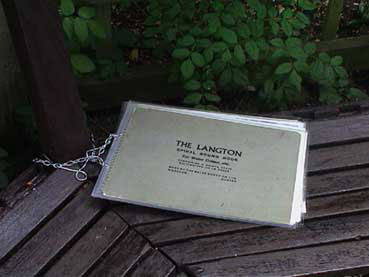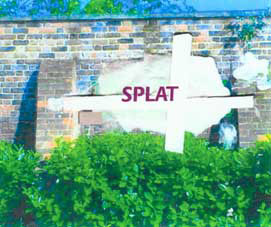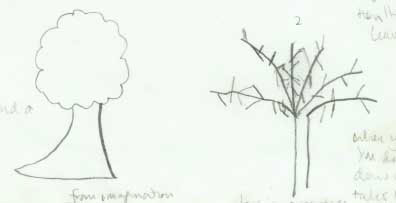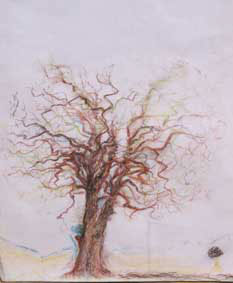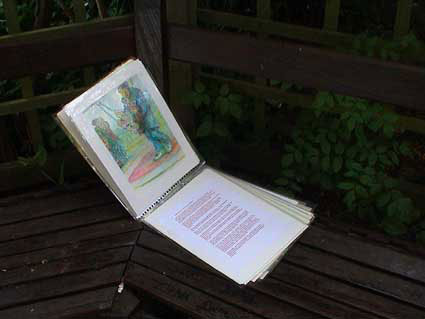ON TO THE NEXT GARDEN OF EARTHLY DELIGHTS ARTIST
| Marilyn Rodgers |
The Secret Garden Collaboration between artist mother Marilyn Rogers and nine-year old daughter Gabby Duncan of ideas for The Walled Garden, Brockwell Park, a special place where reflections take place. History, Memory, Continuation. Prologue… When thinking of how to interpret in an artistic form ‘The Garden of Earthly Delights’ I travelled from the sublime to the ridiculous. I used the recurring idea of Evil undercover, to be confronted, acknowledged and expelled. The Good I found in the creative expression of ideas I found by seeing through my daughter’s eyes, being the child again, looking at the world of the walled garden.
The sketchbook I placed in the garden was a compendium of ideas relating to the theme had been produced in the spring of 2004. As well as a thesis of how new experiences can generate creativity, by working through some ideas with my daughter, just being in the walled garden became a remembering of past times and the sketchbook turned into a scrapbook of mementos.
Twenty years of bringing children in buggies walking with family or groups of adults or coming for a tranquil rest on a hot day. Reading the names of the loved ones left as memories on the benches or, watching the formal planting and the stray weeds grow. Looking in winter the first snowdrops and crocii peep, or in March when the daffodils and tulips lie ragged and browned and the pond with living things in the water and around the edges provides a water feature. The Yew tree and hedges provide hiding places for young children and to see them skipping down the paths on the cracked stone flags. While sitting on the benches and chatting under the pergolas, Gabby and I talked about memory of grandparents, now dead and of times she had come there. I told her of my memories of my grandmother’s garden, which had standard rose bushes formally laid out and each coloured rose tree became another family for me to talk to.
We drew ideas in our sketchbook, clouds came to mind and the possibility of planting stakes into the ground with thoughts on. I imagined: large cloud shapes on the garden walls, which would have words delicately etched or superimposed onto them and would act as a canvas for the sky. Words like, history, memory, continuation, silver lining. She did her own version different more fun…her clouds were looked at from inside a house and said things like SPLAT ….. Tree Drawing In the Millennium Garden, another walled garden in Abercych West Wales, Gabby and I shared another sketching day. It was a dialogue, a conversation about ideas of how to draw a tree drawing together in the sketchbook. I asked her to draw a tree. She drew a cloud shape with a stem. Then I showed her mine. It was spring there were no leaves on the tree. I asked her to look closely see the branches She drew a more considered tree with smaller, thinner branches, Then I asked her to draw it from the tips of the branches down to the trunk.
Later drawing the garden from memory, we put in hedge, trees, clouds and planted little cloud bubbles. It came from an idea of how we could send thoughts to others who were not present or might visit another time. These sentimental, nostalgic feelings grew out of the sense of the place belonging to an earlier time. I made some of these musings into a poem about seeing my daughter walking towards me the sketches of her paddling and playing in the stream in Wales transported me back in time into that Secret Garden, a time when people sent greetings in poetic form as on birthday or anniversary cards.
I said Clouds she said: The Garden of Earthly Delights.
The Secret Garden A place of quiet reflection where people can interchange ideas, thoughts and feelings. This dialogue can be intergenerational between grandparent, parent and child in a place, where one can talk about other things. This was the starting point for the dialogue between myself and my daughter. The ideas generated from the dialogue resulted in initial sketches and ideas for The Secret Garden. The idea of the walled garden being a safe place where one can experience both an interior world and the exterior world of nature is interesting to both the adult and the child. The process of expressing children’s ideas into art is very different from that of the adult. The child uses intuition, comparison and copying to express ideas into concrete drawings or objects. The child thought of the walled space as an interior to look out from through a window. The adult saw it as opening up the sky from within a safe contained space. Both saw it as a place where thoughts could grow. I, as an adult, thought that drawing words like reflection and memory on to the surface of a cloud was a clever way to express ideas floating through one’s mind. Her cartoon-like image of a cloud seen through window frame viewed from inside a house was spatially different, she drew a crosspiece of the window without the frame. She transposed her ideas into words in a different way. She picked up the idea but translated the more abstract concepts of reflection and memory (which for a child are sometimes more difficult to conceptualise), into simpler words relating to sounds one might hear: splash drip splat, sounds of rain falling or trees dripping onto a pond. Her ideas of the walled garden, being like a house without a roof, possibly come from the miniature cast concrete houses just outside the garden gates and now partially demolished. They could be seen as an entry to the smaller safer world within the walled garden itself. This mini-world, child-size also makes the garden a refuge.
An interesting experience for me was the Women’s Art Movement, which provided support, dialogue and criticism at a time I was fully stretched. Why do we do it, Create? I mean can’t we just get through the day, knowing now that just getting through the day is a kind of death, a soap-opera life we live? Creativity is one of the few mechanisms for survival the human race has. It is a cross-cultural, cross-language means to describe the human condition. Since college and my early career as a practicing artist the most creative leaps have occurred when my children were born. Prior to that, the newness of an experience whether an exhibition, new friends or a place could be the catalyst. As I explained in Women's Work: Two Years in the life of a Woman’s Art Collective (1985), a diary of artist as mother, the desire to be involved and to mark out a territory for myself became the impetus behind the struggle to keep going through those years. It echoes the writing in Balancing Acts - on being a Mother edited by Katherine Gieve (1989 - Virago). Written by women professionals, it gave an insight to what other women might be feeling. One account of a woman married to an artist was poignant. The difficulty of maintaining an income, bringing up children, being vibrant and creative and supporting each other took its toll on that relationship. But what this book didn’t recognise, I felt, was the creativity unleashed through childrearing - that feeling of being ALIVE. Susan Wilson’s image on the cover of a self-portrait with baby on her lap, gave an inkling of what a woman who is an artist might be experiencing. I explored colour again, making installations on issues of boundaries, freedom, safety, personal anonymity, and non-recognition. Thinking of the famous Cyril Connelly quote ‘Creativity goes out the window when there is a pram in the hall’ I imagined it differently. Whereas both the male and female parent might feel tied down, some respond selfishly and use their inspiration to exclude others, others respond selflessly/ inclusively - recognising the human experience of creativity. The ‘pram in the hall’ is also a sharing time for many women and men. This brings me to The Secret Garden, which becomes a creative space that is available across gender, age, culture, sexuality and ability. Creativity, child-like innocence, new experiences - these are forces for everyone. A walled garden is a place to encounter feelings of space and time to reflect and be inspired. Observing how children use the space you see them: run, sing, jump, talk to imaginary friends and have a more physical response to their environment. You don’t have to be a child to experience this and it is not exclusive to parents. Finding that quiet space to work through ideas and feelings can resolve problems and create new possibilities. I see this discourse as part of a process of making as an artist. For me it made me reflect on feelings of safety. Discovering how family relationships: mother daughter/son can influence the way I look at the world and what effects being a working mother in an inner city has had on my creative life. Re-discovering the secret garden inside oneself as a creative place. Women particularly find tension between their creativity and their ability to function in the wider world, when demands of childrearing and a working life arise. The feminising aspect also makes for a creative surge relating to the new feelings arousing inspiration, imagination and productivity. These feelings can exist in everyone. The drive occurs when one feels most alive, because the experience is new or seen in a new way e.g. through a child’s eyes. Snake in the Grass This mini-world / mini-me experience of visiting the protected space of a walled garden is of course an illusion. Innocence for children is an illusive thing, often what appears safe, innocent, protected is the most harmful. Whether it is a park, school, street or home, the snake in the grass, the observer, the person one knows, a member of the family can bring harm, an end to innocence. On researching these ideas I read some of Simon Scharma’s Landscape and Memory. His chapter on Walden’s Pond by Henry Thoreau was quite enlightening.
|
|
|
